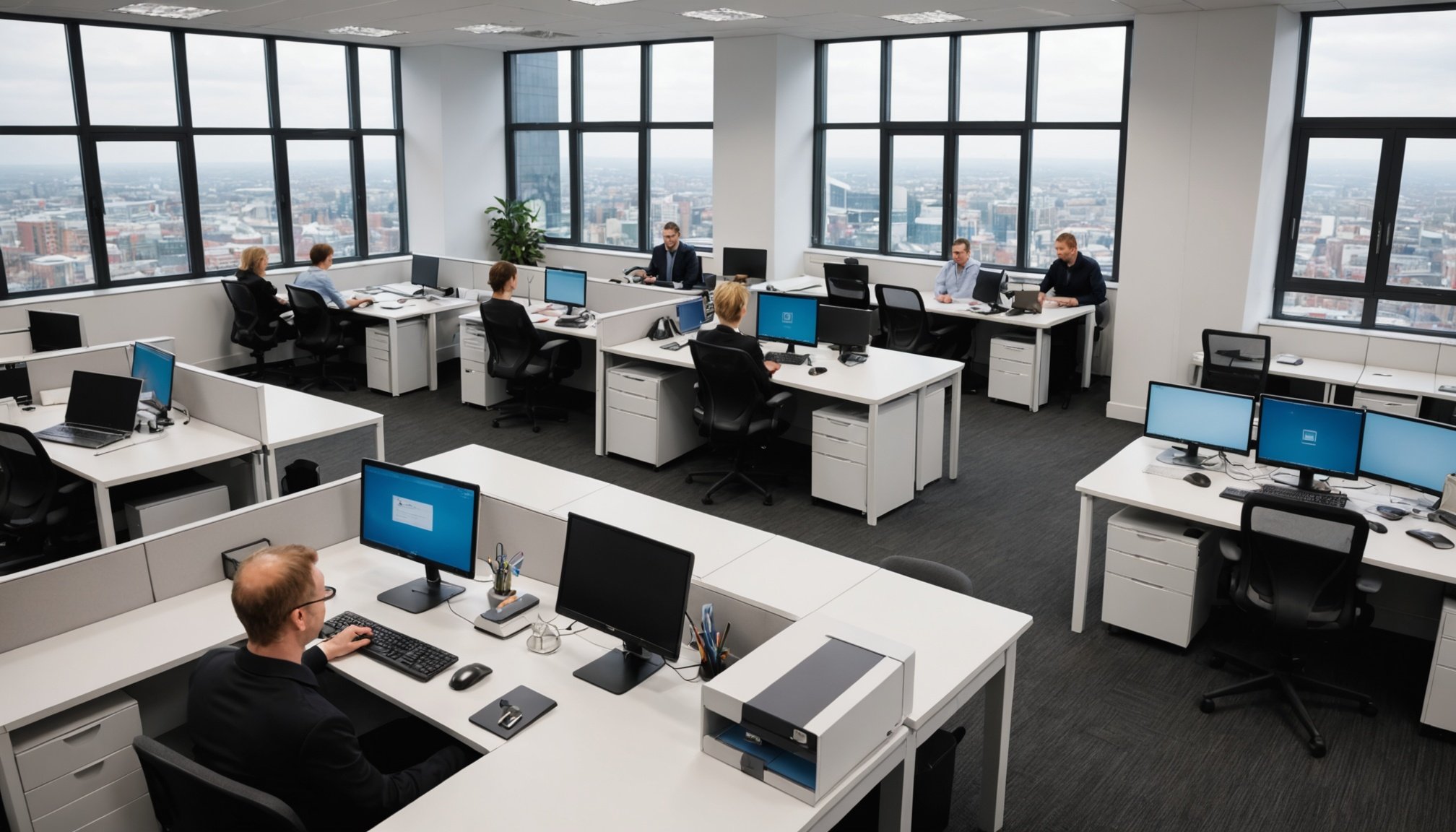Understanding Workplace Efficiency
Workplace efficiency is crucial in the modern office and plays a pivotal role in determining the success of any organisation. It involves optimising processes and resources to maximise productivity. When businesses in regions like Manchester embrace efficiency, they benefit immensely.
Definition and Importance
Workplace efficiency refers to the optimal use of time and resources to achieve desired outcomes with minimal waste. It is integral to achieving high productivity levels, often leading to increased profitability and a competitive edge. In today’s fast-paced world, efficient workplaces are more likely to retain talent and drive innovation.
Have you seen this : Maximizing reach: innovative approaches for leicester training center to capitalize on online courses
Current Trends in Manchester
Recent trends in Manchester highlight the growing emphasis on flexible working arrangements and digital tools to enhance efficiency. Companies are increasingly using office management software to streamline operations and facilitate better communication. This shift not only supports remote work but also fosters a collaborative environment.
Impact on Employee Satisfaction
Efficient workplaces significantly improve employee satisfaction. Employees are more likely to feel motivated and valued in environments where systems are streamlined and clutter is reduced. An efficient workplace management system can lead to reduced stress levels, better work-life balance, and ultimately, happier employees.
This might interest you : Unlocking successful marketing: your ultimate guide to crafting an impactful content calendar for sheffield businesses
Proven Techniques for Enhancing Productivity
When trying to boost productivity, understanding effective time management practices is crucial. Time management involves organising and planning how to divide time between specific activities. Without effective time management, efficiency could suffer. Organizational skills play a vital role in managing one’s time, enabling prioritisation of tasks, which is one of the key productivity techniques.
To prioritise tasks effectively, the most vital step is recognising what’s truly essential. Utilising frameworks like the Eisenhower Box can help distinguish between what’s urgent and what’s important, guiding decisions and actions. By focusing on what needs immediate attention, and what can be scheduled for later, individuals can optimise their workflow.
Minimising distractions in the office environment involves creating a workspace that fosters concentration. Techniques like setting specific work hours, using noise-cancelling tools, and implementing a ‘do not disturb’ policy during peak work times can substantially reduce interruptions.
Breaking tasks into smaller, manageable segments with clearly defined goals can further enhance productivity. This technique not only makes projects less daunting but provides a clear path forward, keeping momentum and motivation high. By consistently applying these productivity techniques, individuals can improve both efficiency and workflow management.
Case Studies of Successful Implementation
Examining how local businesses spruced up their operations can be quite enlightening. Let’s dive into some real-life examples.
Company A: Transforming Office Culture
Once beset by low morale and inefficiencies, Company A decided to shift gears. Their primary challenges included siloed departments and slow communication. In response, they overhauled their internal processes, aiming to improve communication and streamline operations. This involved regular team meetings and fostering a culture of open dialogue. The results? Remarkable! Employee feedback revealed increased satisfaction, with team members feeling more valued and engaged.
Company B: Leveraging Technology
Facing outdated systems, Company B adopted cutting-edge tools to boost productivity. Technologies such as AI-driven scheduling and CRM software transformed their daily operations. Employees initially struggled but soon adapted, finding work streamlined and less cumbersome.
Company C: Fostering Collaboration
Focused on nurturing team collaboration, Company C implemented initiatives in various departments. They balanced open office spaces with private areas to encourage creativity while respecting individual work preferences. This strategic spatial planning improved cross-team communication significantly, as measurable by increased project outputs and inter-departmental collaboration ratings. Employees appreciated the supportive atmosphere, noting improvements in both teamwork and individual productivity.
Localized Advice for Manchester Offices
Understanding Manchester office culture is key for businesses looking to thrive in the city. The unique blend of tradition and innovation defines Manchester, where businesses often blend traditional practices with cutting-edge technology to drive efficiency. One aspect that stands out is the informal yet professional atmosphere, encouraging open communication and collaborative work environments.
Incorporating local business practices can significantly enhance productivity. Many companies in Manchester value community engagement and sustainability, practices which are deeply ingrained in the city’s corporate ethos. Restaurants sourcing local produce and companies hosting eco-friendly events are common ways businesses contribute to the community.
Networking is another vital component. Manchester offers a robust network of resources aimed at supporting businesses. Organisations like Manchester Digital and pro-manchester provide platforms for businesses to connect, share ideas, and gain valuable insights. These community insights are invaluable, particularly for startups or businesses new to the area, as they offer a supportive environment to grow and innovate.
By embracing these unique cultural aspects, and leveraging the local resources available, businesses can achieve not only efficiency but also a strong presence within the Manchester community.
Tools and Technologies for Efficiency
In the modern workplace, efficiency tools and tech solutions play pivotal roles in maximising productivity. They offer significant advantages by streamlining tasks and fostering collaboration through seamless digital means.
Digital collaboration platforms have revolutionised how teams work, making communication smoother and more cohesive. Applications such as project management tools, cloud storage solutions, and messaging apps allow employees to digitally collaborate, regardless of their physical location. This not only saves time but enhances productivity by ensuring everyone is on the same page. For instance, many companies in Manchester have reported increased efficiency and reduced project timelines following the implementation of these technologies.
Case studies illustrate that Manchester-based businesses embracing these tools have observed tangible benefits. A well-known software firm in the city reported a 30% increase in project output after adopting a suite of tech solutions. This included tools that facilitated digital collaboration and streamlined administrative tasks. Companies embracing these tools have found that they foster a more efficient work environment, improve communication, and ultimately drive better business results.
Integrating the right efficiency tools and tech solutions is crucial for modern offices aiming to keep up with the fast pace of today’s business world. Embracing these technologies enables companies to enhance productivity while maintaining effective collaboration.
Future Trends in Workplace Efficiency
As we look ahead, the future of work is rapidly evolving, pushing workplace efficiency to new heights. Fast-paced industry trends are transforming office environments, leveraging technology in ways we couldn’t have imagined a few years ago. Remote work, now a staple feature in many companies, significantly influences office dynamics, enabling flexibility while maintaining productivity.
In the coming years, expect further integration of AI-driven tools aimed at streamlining workflows and reducing mundane tasks. These innovations include virtual assistants, smart scheduling, and even automated project management tools designed to enhance productivity. For example, AI systems can quickly sift through data, offering insights that would take humans considerably longer to discern.
Moreover, the role of data analytics in decision-making processes will likely grow, with real-time data supporting more informed choices. Also, enhancing communication tools will see greater emphasis, ensuring that teams stay connected, irrespective of their geographical locations.
To stay ahead, workplaces must embrace these trends and innovate actively to maintain efficiency. As new challenges and opportunities emerge, adopting such tools will become crucial in navigating the ever-changing landscape of the business world.











